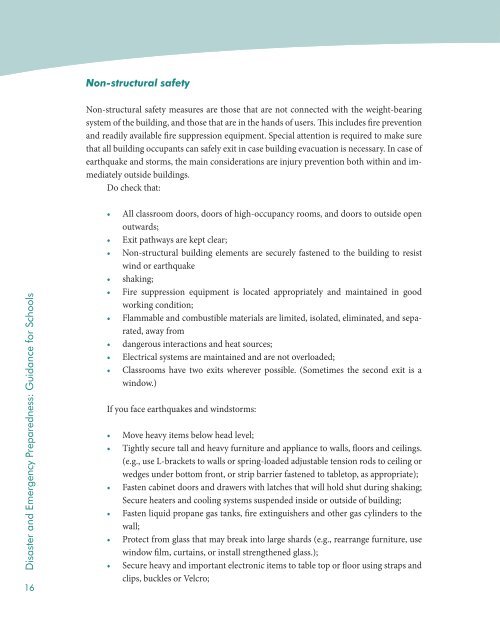Non-structural safetyNon-structural safety measures are those that are not connected with the weight-bearingsystem of the building, <strong>and</strong> those that are in the h<strong>and</strong>s of users. This includes fire prevention<strong>and</strong> readily available fire suppression equipment. Special attention is required to make surethat all building occupants can safely exit in case building evacuation is necessary. In case ofearthquake <strong>and</strong> storms, the main considerations are injury prevention both within <strong>and</strong> immediatelyoutside buildings.Do check that:<strong>Disaster</strong> <strong>and</strong> <strong>Emergency</strong> <strong>Preparedness</strong>: <strong>Guidance</strong> <strong>for</strong> Schools16All classroom doors, doors of high-occupancy rooms, <strong>and</strong> doors to outside openoutwards;Exit pathways are kept clear;Non-structural building elements are securely fastened to the building to resistwind or earthquakeshaking;Fire suppression equipment is located appropriately <strong>and</strong> maintained in goodworking condition;Flammable <strong>and</strong> combustible materials are limited, isolated, eliminated, <strong>and</strong> separated,away fromdangerous interactions <strong>and</strong> heat sources;Electrical systems are maintained <strong>and</strong> are not overloaded;Classrooms have two exits wherever possible. (Sometimes the second exit is awindow.)If you face earthquakes <strong>and</strong> windstorms:Move heavy items below head level;Tightly secure tall <strong>and</strong> heavy furniture <strong>and</strong> appliance to walls, floors <strong>and</strong> ceilings.(e.g., use L-brackets to walls or spring-loaded adjustable tension rods to ceiling orwedges under bottom front, or strip barrier fastened to tabletop, as appropriate);Fasten cabinet doors <strong>and</strong> drawers with latches that will hold shut during shaking;Secure heaters <strong>and</strong> cooling systems suspended inside or outside of building;Fasten liquid propane gas tanks, fire extinguishers <strong>and</strong> other gas cylinders to thewall;Protect from glass that may break into large shards (e.g., rearrange furniture, usewindow film, curtains, or install strengthened glass.);Secure heavy <strong>and</strong> important electronic items to table top or floor using straps <strong>and</strong>clips, buckles or Velcro;
Secure lighting fixtures to ceiling;Fasten pictures on closed hooks;Limit, isolate, eliminate or secure hazardous (poison, flammable) materials.And <strong>for</strong> floods:Raise important items above possible flood level;Limit, isolate, eliminate or secure hazardous (poison, flammable) materials aboveflood level.Local infrastructure safetyLocal infrastructure includes the water, electricity, gas, heating <strong>and</strong> cooling systems, communications<strong>and</strong> transportation systems in your area. These are usually part of larger systemsmaintained by government <strong>and</strong> private agencies. Careful design <strong>and</strong> problem-solving withthese organizations, ahead of time, can protect students <strong>and</strong> educational assets, <strong>and</strong> makethese systems resilient. Depending on the hazards faced, a wide variety of solutions can beconsidered:Relocate overhead wires <strong>and</strong> poles that may block exit routes;Install automatic natural gas shut off valves at building level;Use flexible connectors <strong>for</strong> pipes;Consider dangers posed by overhead <strong>and</strong> underground pipes <strong>and</strong> depots;Replace radioactive lightening rods with those that do not pose health risk.Transportation safety may involve road <strong>and</strong> pedestrian crossing conditions as well asoperations of school or contractor buses or minivans. On an annual basis, worldwide, transportationaccidents are the leading cause of student deaths <strong>and</strong> injuries. Clear lines of sight<strong>and</strong> signage, stop signs, traffic lights, clearly marked pedestrian crosswalks, <strong>and</strong> crossingguardsat busy crossings are all important safety measures. Vehicle safety, driver testing <strong>and</strong>training, <strong>and</strong> installation, maintenance, <strong>and</strong> use of seat belts, <strong>and</strong> careful routing are all ofimportance in ensuring that students are safe in school transport. Once on school transportation,rules of access <strong>and</strong> conduct, <strong>and</strong> adult supervision are also important factors.Environmental safetyEnvironmental safety issues bring schools into focus in their local environments. Thinkingthrough all of the conditions that you face, what are some of the environmental safety issuesto explore to increase your own safety?School <strong>Disaster</strong> Management17
- Page 1: The Connected Vehicle5.9 GHz DSRC f
- Page 5 and 6: ContentsForewordviiIntroduction 1Sc
- Page 7 and 8: ForewordThis handbook and its compa
- Page 9 and 10: IntroductionMore than 400 national
- Page 11 and 12: School Disaster ManagementSchool Di
- Page 13 and 14: 1. Assessment and planningAssessmen
- Page 15 and 16: vention awareness in the school com
- Page 17 and 18: D. Find the relative risk score, by
- Page 19 and 20: Priority 1: secure items that can k
- Page 21 and 22: On the Neighborhood Map mark vulner
- Page 23: And last but not least, students wi
- Page 27 and 28: Standardization - the use of common
- Page 29 and 30: Incident Command Systems Organigram
- Page 31 and 32: Staff: ahead of time, practice as a
- Page 33 and 34: necessary, or when there is not tim
- Page 35 and 36: Reunification Team: greets parents
- Page 37 and 38: When you are in transit. When trave
- Page 39 and 40: If you are indoors, stay off all te
- Page 41 and 42: Emergency Procedures Decision-TreeR
- Page 43 and 44: Report findings to Operations Chief
- Page 45 and 46: Work with the cafeteria and ICC to
- Page 47 and 48: the drill, students can debrief wit
- Page 49 and 50: ReferencesGFDRR and INEE, Guideline
- Page 51 and 52: Addenda:Comprehensive School Safety
- Page 53 and 54: addressed and implemented at the lo
- Page 55 and 56: 5. Schools have and practice polici
- Page 57 and 58: In Column B, the likelihood of occu
- Page 59 and 60: “L”-shaped, “H”-shaped, “
- Page 61 and 62: We have a fire extinguisher and mai
- Page 63 and 64: Other variationsTo make this a real
- Page 65 and 66: if there is an earthquake when they
- Page 67 and 68: Class Status Report FormReturn this
- Page 69 and 70: Emergency Provisions ChecklistsADMI
- Page 71 and 72: 1 RADIOBATTERIES1 WHISTLE4 EMERGENC
















